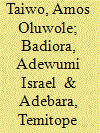|
|
|
Sort Order |
|
|
|
Items / Page
|
|
|
|
|
|
|
| Srl | Item |
| 1 |
ID:
193037


|
|
|
|
|
| Summary/Abstract |
Against the background of seemingly uncontrollable social menace and environmental nuisance of street children, this study examined the effects of open space characteristics on the spatial distribution of street children in Ibadan, Nigeria. With open space types in the city as spatial units of data collection, enumeration of street children was carried out in each space type within 7 weekdays in the morning, afternoon and evening. Observation was also conducted to know the socio-economic and physical characteristics of the urban environment attracting the children. The study, which employed z-scores to compare the intensity of street children incidence across the spatial units, confirmed that the incidence was a function of the uses to which open space types were put as well as the disorderliness of urban physical environment (indiscriminate parking, formal and informal economic activities, and so on). The most important open space types that attracted street children were markets, mosque premises and junctions. Although, incidence of street children was a daily affair in Ibadan, it was highly pronounced in the evening on Saturday, Friday and Monday. The study recommended development of policy measures for regulating the use of open spaces, and giving adequate planning attention to roundabouts, religious centres (mosques in particular) and markets in urban centres. It also recommended public education and enlightenment programme on the negative effects of street children incidence by all stakeholders, and that the aspect of culture of the people that encourages child begging and alms giving should be discouraged in its entirety.
|
|
|
|
|
|
|
|
|
|
|
|
|
|
|
|
| 2 |
ID:
193041


|
|
|
|
|
| Summary/Abstract |
This article investigated the intra-urban distribution of child hawking in Enugu Municipality, Nigeria. The study first enumerated child hawkers across three residential areas (core, transition and sub-urban) simultaneously on different weekdays and at different locations (activity-nuclei) in Enugu municipality. A questionnaire was then employed to obtain information from 95 incidentally selected child hawkers, comprising 49, 21 and 25, respectively. Information sourced was their socio-economic characteristics and factors influencing their taking to the street to hawk. The data were analysed using percentages, cross tabulation and standard scores. Results showed that 58.9% were males, 53.7% were out-of-school and 47.4% realized ₦501.00–₦1000.00 ($1.4USD–$2.78USD) per day. Factors influencing child hawking, measured through an index tagged ‘Child Hawkers’ Factor Index’ (CHFI) on a 5-point Likert-type scale, showed that poverty was the most prevalent factor in the core, transition and sub-urban areas of the municipality, respectively, with (CHFI = 3.67), (CHFI = 3.64) and (CHFI = 3.37). The study further showed that there was a relationship between child hawking incidence and land use activities. It observed that the core residential area, junction, Motor Park and market land uses were generators of child hawkers. The study suggested effective urban planning and policy measures in addressing the menace of child hawking.
|
|
|
|
|
|
|
|
|
|
|
|
|
|
|
|
| 3 |
ID:
182473


|
|
|
|
|
| Summary/Abstract |
Against the background of the solution-defying incidence of child labourers in Nigerian cities, this study examined the relationship between public spaces and incidence of child labourers in Ibadan Municipality, Nigeria. Data were obtained through direct counting of child labourers and cursory observation of the physical and environmental compositions of their places of operation. The direct counting was conducted for seven days of the week in the morning, afternoon and evening within defined activity-nuclei purposively selected across three densities of residential areas of the municipality: high, medium and low. The data collected were subjected to descriptive statistics. Findings showed that the incidence and categories of child labourers varied with public spaces and density of residential areas, and also followed the concentric, sector and multiple nuclei theories of urban land use. The study, therefore, recommended that urban planners and government have roles to play in offering lasting solution to the menace of child labour.
|
|
|
|
|
|
|
|
|
|
|
|
|
|
|
|
|
|
|
|
|